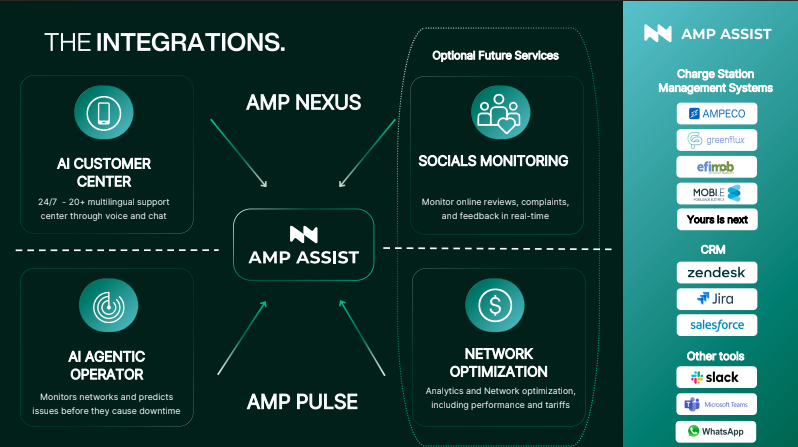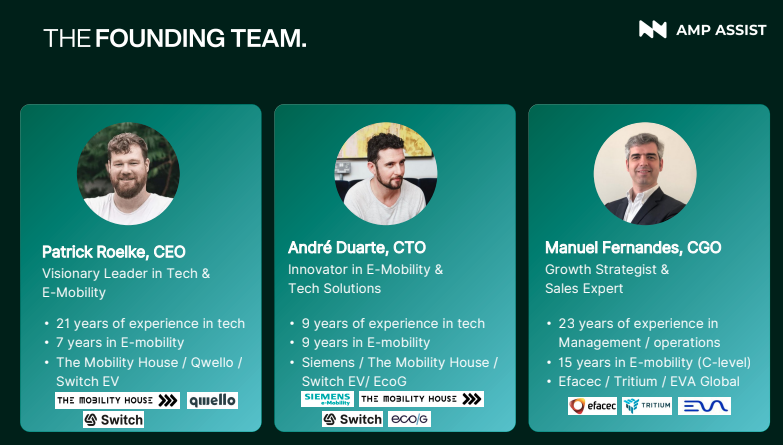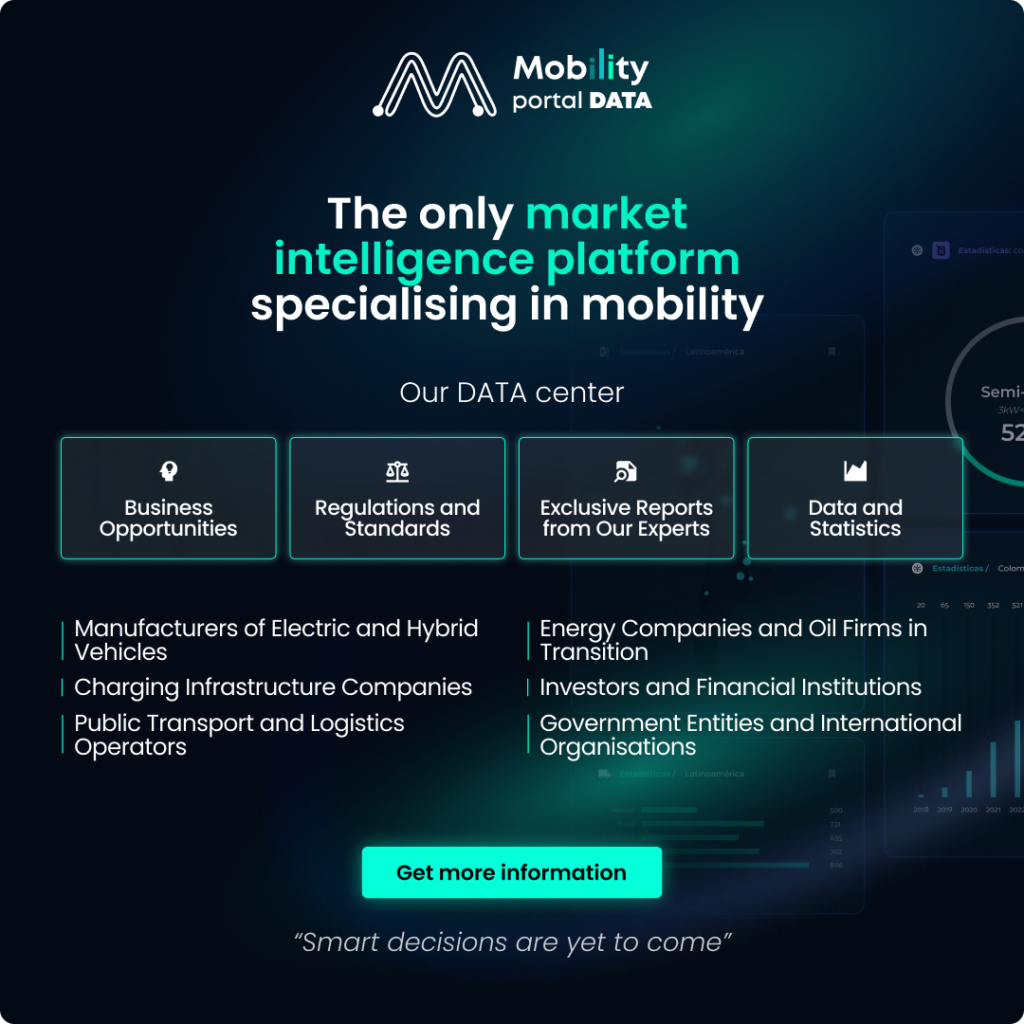Electric mobility is progressing across Europe, and with it, the challenges related to user experience and the profitability of charging networks are also increasing.
According to data from ChargerHelp, 20% of charging sessions in Europe and the United States fail—directly affecting driver satisfaction and operator revenue.
In response to this scenario, Amp Assist was founded by Patrick Roelke (CEO), André Duarte (CTO), and Manuel Fernandes (CGO).
Their proposal?
It is based on two pillars — AMP Nexus and AMP Pulse — which aim to reduce incidents and increase the efficiency of charging operations through artificial intelligence.

“What we see is that problems persist with EV charging. It doesn’t always work: you go to a charger, plug in, and it doesn’t charge. The data shows a significant failure rate,” warns Manuel Fernandes in an exclusive conversation with Mobility Portal.
He stresses that these failures have consequences beyond the technical: they undermine user trust and erode brand loyalty.
“An operator who fails to meet their customer’s expectations loses loyalty, generates a negative brand perception, and misses out on the potential revenue that the charging session could have brought,” he adds.
From EVA Global to the creation of Amp Assist
Based on his experience at companies like Efacec, Tritium, and EVA Global, Fernandes recognised the need for a paradigm shift in support management. He states:
“The best call is the one that never happens—because we solve the issue beforehand, thanks to proactive monitoring and analytics.”
The story of Amp Assist is deeply tied to the journey of its three founders.
Fernandes worked on the operational and sales side with manufacturers and at EVA Global, where he observed first-hand the limitations of traditional call centres.
Duarte developed backends, stacks, and protocols, including the latest standards like ISO15118 and OCPP 2.x. He began his career at Siemens and later worked with international leaders such as The Mobility House, SwitchEV, and EcoG.
Meanwhile, Roelke brought his experience from The Mobility House, Qwello, and SwitchEV, where he built software for chargers and backend systems. Both he and Duarte co-authored the most widely used open-source OCPP library.
Their shared goal was to bring all that expertise into Amp Assist—an AI-driven model capable of improving systems and the user experience.

“Our aim is to position ourselves as a business process outsourcing company. Today, an operator might have five people in front of monitors, supervising the network 24/7,” Fernandes explains.
He adds: “We’ve developed AI systems that can perform those tasks continuously and, when detecting anomalies, can act and resolve them automatically.”
Amp Assist’s two pillars: Amp Nexus and Amp Pulse
With Amp Nexus, the company offers an AI-powered customer support centre capable of interacting with drivers, installers, service technicians, and operations teams via voice, chat, WhatsApp, email, or social media.
“What we’ve developed is an interactive solution that can operate through a phone call, a written conversation, or an email exchange,” he says.
The second pillar, Amp Pulse, is an operational agent system acting as a digital operator monitoring the network’s status. As Fernandes puts it:
“Amp Pulse is a digital operator—a system agent—that essentially sits in front of the screens and supervises the network.”
The solution integrates with various charge point management systems (CPMS), such as Ampeco, GreenFlux, Mobi.e, as well as AFIR-compliant payment terminals and, soon, with several EVSE OEM platforms.
This integration simplifies the management of fragmented systems and platforms.
“We can respond to a call in five seconds—not just one, but a thousand simultaneously. That’s the power of AI: it doesn’t take breaks, it doesn’t go to lunch, and it doesn’t need the toilet,” Fernandes highlights.
Moreover, the systems are designed to learn from every interaction.
“Our goal is for each learning cycle to take us one step further. If there’s a case we couldn’t resolve and had to escalate to the manufacturer, and their engineer creates a new procedure, we incorporate it so that next time we can solve it instantly.”
Amp Assist: profitability, expansion, and cultural barriers
The potential of Amp Assist is global. While it began operations in Europe, the model is replicable in any market thanks to the standardisation of protocols such as OCPP and CCS.
As Fernandes points out: “We have no management, language, or system barriers, because chargers are sold worldwide. We’re already in talks with a company in Brazil, one in New Zealand, several in Europe, and one contact in the United States.”
Amp Assist also plans to work directly with manufacturers and installers.
“For example, if a manufacturer sells you a home charger and there’s no operator, you install it at home. Later, you want to add another family member and can’t. So, you open a chat in the app or a WhatsApp message, and we can provide direct support,” he explains.
However, the challenge isn’t just technological—it’s also cultural.
“I think it’s largely cultural. Switching to an electric vehicle means accepting some of its limitations, but everything else is positive. We see ourselves as helping shift habits and build trust in electric mobility.”
Company reports highlight recurring issues: lack of user training, connectivity problems in certain areas, and the absence of adequate maintenance plans.
In this regard, Fernandes adds:
“There’s a major lack of knowledge among EV owners—nobody explains the basics of how to charge. We also see issues in locations without a reliable network, and in the maintenance of equipment. We don’t perform miracles—if a charger is broken, it’s broken. But we can help prevent it from happening again.”
The ultimate goal, as Fernandes summarises, is clear: to bring efficiency and profitability to a rapidly expanding market.
“If you’re growing, focus your team on the high-value work and let us handle the operational tasks. Your team becomes more productive, more valuable—and we take care of what’s repeatable,” he concludes.
DISCOVER MOBILITY PORTAL DATA
Explore Mobility Portal Data, an exclusive new market intelligence platform offering reliable data and key reports to support smart decision-making across the automotive sector—covering both combustion and electric vehicles, as well as charging infrastructure.
Research, trend analysis, and clearly presented statistics—together with up-to-date insights—all in one place.
With Mobility Portal Data, the best decisions are just a click away.








